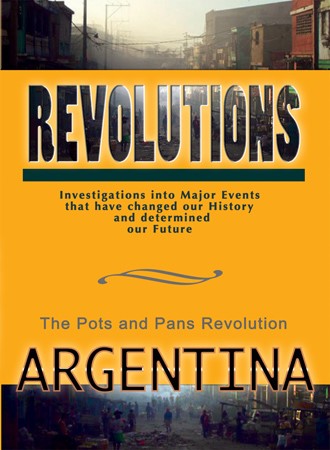
Argentina: The Pots and Pans Revolution 2012
Distributed by Film Ideas, 308 North Wolf Rd., Wheeling, IL 60090; 800-475-3456
Produced by FI Channels
Directed by Philippe Claude and Philippe Lachambre
DVD , color, 52 min.
Sr. High - General Adult
Economics, Political Science
Date Entered: 10/16/2013
Reviewed by Michael J. Coffta, Business Librarian, Bloomsburg University of PennsylvaniaDebt, recession, the global financial crisis, and rigid parity with the US dollar economically crippled Argentina in 2009. Dissatisfaction with the Argentinian government officials and a gridlocked banking system led to riots. With this backdrop, this film offers a day by day account of the “pots and pans” revolution, in which Argentinians took to the streets pounding their empty pots and pans, as a symbol of hunger and political protest. The mostly peaceful protests did indeed lead to political pressures, resulting in the removal of key government officials.
The filmmakers return to Buenos Aires one year after the pots and pans revolution, examining the people’s plight, and the still-moribund banking system, in which banks cannot cover withdrawals. After many business owners took their money and fled the country, an interesting phenomenon developed. In the absence of these executives, employees took the opportunity to buy, manage, and operate the factories, offices, etc. to reinvigorate the Argentinian economy. Mass privatization, however, has been blamed for heavy unemployment, and many believe that these seemingly grass root revitalizations to have been a political maneuver of the ousted president to deflect blame for the economic woes of the nation.
In three distinct sections, the film sweeps from themes of economics to a personal piece to a strong historical section. In this last section, the filmmakers offer a history of coups, purges, and oppression in Argentina beginning in 1976. Interviews state that while the regimes may have changed, the legacy of the junta of this period has increased the nation’s perennial acceptance of violence and human rights violations.
In the midst of the Arab Spring, many such revolutions hoped to gain traction among the populace, leading to positive political energy within the country and a positive perception of the country on an international level. Despite the plebian tone of the pots and pans symbol, the film has a dark tone to it. The plight of the impoverished, such as those collecting plastic and cans for income, is sewn throughout the film. There is no resounding conclusion of either victory or progress. In fact, the film concludes with an assertion that the Argentinian people have an engrained distrust of all politicians.
The real strength and critical value of this work lies in its examination of privatization. In its entirety, it offers a well-balanced representation of the economic and political climates of Argentina, as depressed as those climates may be.